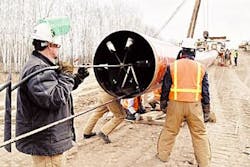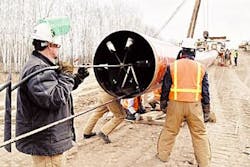D. M. Scott
Enbridge Energy Partners LP
Edmonton
The second edition of American Petroleum Institute (API) Standard 1130 for computational pipeline monitoring (CPM) will be published later this year.
The standard was first published in 1995 to provide guidance to the pipe line industry on the subject of software-based pipeline leak detection.
When the US Department of Transportation's (DOT) Research and Special Programs Administration (RSPA) was required to set regulations for this aspect of pipeline leak detection, it incorporated in July 1998 the first edition (1995) of API 1130 by reference into the liquid pipeline regulations 49 CFR Part 195 "Transportation of Hazardous Liquids by Pipeline." (CFR = Code of Federal Regulations) References to API 1130 are in paragraphs 195.134 and 195.444.
Thus, API 1130 became a regulatory requirement mandating that if a liquids pipeline company has applied a CPM system, it must conform to API 1130.
Reviewed here are the process of republishing the standard, the important changes incorporated into the second edition, and some of the major implications of those changes.
Review
API requires its standards documents to be reviewed and reauthorized (or at least the reauthorization process must begin) at 5-year intervals. In the case of API 1130, assurance that the standard remains current is especially important because it is incorporated by reference into regulations.
Also, because API 1130 describes a new technical subject, it is prone to becoming outdated as technology rapidly changes through application.
Finally, because the 1995 edition was the initial publication, it was to be expected that it would need future review to improve its contents, especially considering the pipeline industry's experience with CPM since 1995.
In late 2000, the API's cybernetics committee was assigned the work of reviewing and updating API 1130 so that it could be reissued. The committee formed a task force to review and possibly rewrite API 1130 and set a tight deadline for completion of the work.
The task force consisted of representatives from five API-member pipeline companies and one representative from DOT's Office of Pipeline Safety (OPS) and had the resources of the overall committee available for draft review.
During the review process, CPM software vendors and system integrators were invited to have input. This input was broader than that received in the initial writing of API 1130. The input from these groups, all of which have an interest in API 1130, was valuable and made the second edition much improved over the first.
All sections of the API 1130 first edition were subjected to careful scrutiny by the task force and other contributors. At the very least, a few wording changes were made to all sections. In some cases, the modifications were minor. Other sections were substantially altered from the original text in the 1995 document.
The review involved five drafts with outside input solicited at Draft 2 and again at Draft 3 from a few who were substantial contributors. Each draft was issued in an Microsoft Word format for input.
The task force was careful to note to those who received the draft that this was not a final copy to avoid "bootleg" or incomplete copies being used in industry. The final draft went to API for its editing and formatting, which is performed after balloting so that the document is truly final.
At the Draft 5 stage, a working group of 12 members from the cybernetics committee had a 2-day meeting to finalize the work. Throughout the document, the words "should," "shall," and "must" were considered to make sure they were appropriate. After one final committee review opportunity, the new document was forwarded to API for balloting and reprinting.
Overall, the new API 1130 is slightly longer (about 20% more words) than the original due to new text.
Section 6 "Operation, Maintenance and Testing" forms the core of API 1130. Most of the task force effort and discussion were concentrated on this section. It contains most of the "must do" aspects of API 1130, and therefore is the section that will most affect the document's application.
Second edition
Several minor changes are of note:
•The title was changed to reflect that API 1130 pertains to liquid pipelines.
•The overall readability of the document was improved.
•Three sections of the old document (Transportation, Definitions, and Types of Internal Based Systems) were moved in the document to where they would be a better fit.
•Section 5 "Technical Details" was reviewed and rewritten. The task force discussed the usefulness of this section and concluded that, although Section 5 is not core to API 1130, it provides useful information and a few requirements or considerations. This section may also provide a few "design criteria" as mentioned in the regulations.
•Appendix A was reviewed and edited and 14 new definitions were added.
•Appendix B was rewritten to improve readability and the graphic was changed to reflect reviewer suggestions. The rupture definition was an important aspect of the first edition because regulatory proposals at that time focussed on CPM ability to detect "ruptures."
Current regulations place less emphasis on rupture detection. It may be that the new regulations requiring integrity-management plans for liquid pipelines in high-consequence areas will make Appendix B information more important.
More substantial changes occurred in these sections:
•Appendix C had the entirely new concept of "inference engine and alert algorithm" added. The appendix provides a description of those two parts and a graphic that shows how they interact with data and with each other. It is intended that this breakdown into component parts will help the reader of API 1130 to understand the principles upon which CPM is based.
•A "Regulatory Considerations" section was added to reflect the fact that API 1130 referenced in 49 CFR Part 195 and this section therefore highlights the regulatory aspects of API 1130. Users of API 1130 should recognize that aspects of the API 1130 document may outline the enforceable regulatory requirements of Part 195 during regulators' audits of CPM systems.
•The "Selection Criteria" section was rewritten and 16 additional consideration items added. Also, the text was modified to indicate clearly to the users that these are desirable features but that any particular CPM system would unlikely be able to meet all the criteria.
•The "Display Ergonomics" section in the Second Edition provides a few of the significant features that would be expected in the displays associated with a CPM.
•The section on "Types of CPM Alarms" discusses:
Operational response to the three types of alarms.
Need to develop procedures for alarm response.
The phrase "Unusual Operating Condition" replacing "Transient Pipeline Operating Condition" in the first edition.
Alarm evaluation necessary for all "Possible Commodity Release" alarms.
•"System testing" received the most attention of any section considered by the task force. The various types of CPM tests can be difficult and expensive to perform. The second edition offers several options for testing and clarifies confusion in the first edition.
•The "Testing Methods" section suggests that other test methods (unspecified) may be suitable in addition to the three suggested in the first edition and that unannounced tests are used only if the CPM performance has already been established.
•The "Initial Tests during CPM Commissioning" clarifies that simulated tests are suitable for commissioning tests.
•The "Re-Testing" section is much more extensive than in the first edition. It recognizes that if a CPM system detects an actual commodity release, that event can serve as a valid retest for the specified 5-year retest interval.
•The "Maintenance Testing" section is more thoroughly explained in the second edition. The section allows the user to forgo recording of test results, but if the tests are fully documented the maintenance test may be considered to be a retest.
•The "Test Records" section renames the first edition section called "Record Keeping." It also adds requirements that test records for two previous tests should be retained (rather than the unspecified number in the first edition) and that the details of the test reasons and methodology should be recorded.
•The "Parameter Changes" section suggests that CPM parameter changes that are made by pipeline controllers be recorded in a log.
•"System Data Retention" is renamed from the First Edition and makes fewer recommendations as to what data to retain, leaving that decision more up to the individual company, and recommends that all leak-declaration occurrences should be documented.
•The "Pipeline Controller Training & Retraining" section adds the word "Retraining" to the same section from the first edition. It recommends that the pipeline controller be trained to employ the results of other detection methods to corroborate a CPM alarm and that any CPM support staff should also be trained.
Impact of changes
DOT regulations, 49 CFR Part 195, sections 195.134 and 195.444 refer to API 1130. In brief, they specify compliance with the selection criteria of API 1130, with any design criteria, and with all aspects of operation, maintenance, testing, data retention, and controller training (that is, Section 6 in API 1130).
Any new or additional regulatory requirements that arise out of the second edition of API 1130 are uncertain at this time. With application of the rules, the DOT's pipeline safety inspectors will make those clear.
Each pipeline operator that has a CPM system should:
•Read the sections of 49 CFR Parts 195 that mention CPM system.
•Carefully scrutinize API 1130 to de termine the requirements of the document.
•Discuss the CPM regulatory requirement with the DOT's pipeline safety inspectors.
A study of API 1130 may enable speculation on what will be necessary to meet regulatory requirements. In particular, Section 6 of API 1130 ("Testing, Documentation and Operator Training") may require that a pipeline company incur additional work and costs in its CPM operation.
A few of the issues that may need to be considered are:
•A pipeline operator should be familiar with regulations concerning CPM or leak detection that may be mandated by various levels of government.
•"Calibration and Maintenance of CPM Instrumentation" contains three "should" statements concerning preparation of a test and calibration plan, documenting test and recalibration, and coordination of test and recalibration work between the control center and field staff.
•"Display Ergonomics" notes that the CPM developer-integrator should consider the display aspects that are listed.
•"Alarm Display," in all paragraphs of the section, contains "should" statements for displays and alarms.
•CPM alarms should be logged and retained, and all CPM displays should be easily accessible to a pipeline controller.
•There are so many requirements contained in Section 6 that the user of API 1130 should carefully read this entire section and note them.
The author
D. M. Scott works for Enbridge Energy Partners LP, Edmonton, where he is a specialist in supervisory control and data acquisition (SCADA) with 15 years' experience in computational pipeline monitoring, simulation, and modeling for pipelines. He is a mechanical engineering graduate (1970) of the University of Manitoba. Scott served as secretary of the committee that produced the first edition of API 1130 and led the API Cybernetics Task Force that produced the second edition.




